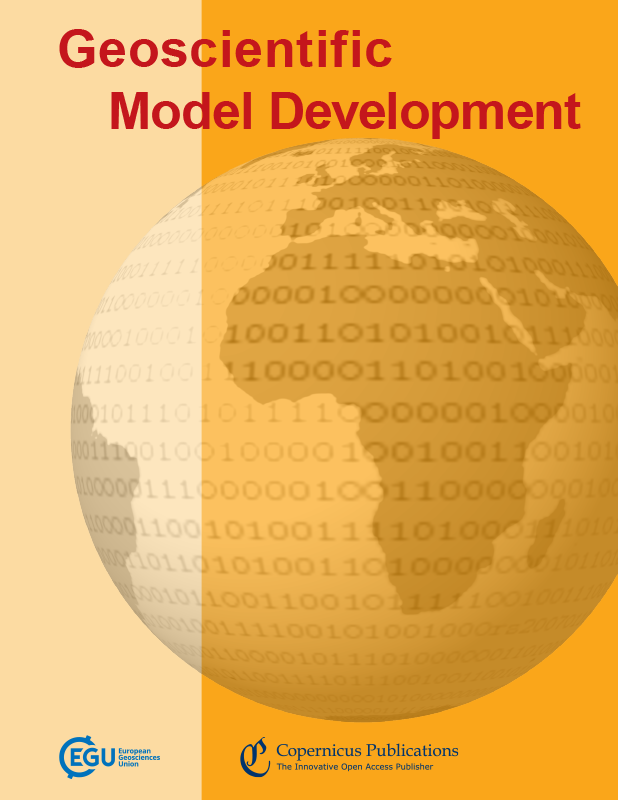使用CESM (v2.1.0)和DART (v9.11.13) -RTTOV (v12.3)同化AMSU-A辐射
IF 4.9
3区 地球科学
Q1 GEOSCIENCES, MULTIDISCIPLINARY
引用次数: 0
摘要
摘要为了改善数值天气预报的初始条件(“分析”),我们尝试吸收来自低地球轨道卫星上的高级微波探测单元- a (AMSU-A)的观测结果。本研究使用的数据同化系统由数据同化研究试验台(data assimilation Research Testbed, DART)和社区地球系统模型(Community Earth system Model)作为全球预报模型组成。DART基于集合卡尔曼滤波方案,支持辐射传输模型,用于从模型状态模拟卫星辐射。为了使AMSU-A数据能够被DART同化,开发了包括质量控制、空间细化和偏差校正在内的预处理模块。在质量控制中,根据云层状况和地表类型,包括离群值检验和通道选择两个子过程。偏置校正过程分为扫描偏置校正和空气质量偏置校正。与DART中使用的输入数据一样,对AMSU-A信道的观测误差也进行了估计。在试验中,通过在DART数据同化系统上同化AMSU-A观测结果,获得了积极的分析影响,DART数据同化系统已经使用了常规测量。特别是在整个对流层和北半球平流层下层,分析误差明显减小。总的来说,本研究表明,当AMSU-A观测在DART同化系统中同化时,对分析有积极影响。本文章由计算机程序翻译,如有差异,请以英文原文为准。
Assimilation of the AMSU-A radiances using the CESM (v2.1.0) and the DART (v9.11.13)–RTTOV (v12.3)
Abstract. To improve the initial condition (“analysis”) for numerical weather prediction, we attempt to assimilate observations from the Advanced Microwave Sounding Unit-A (AMSU-A) on board the low-Earth-orbiting satellites. The data assimilation system, used in this study, consists of the Data Assimilation Research Testbed (DART) and the Community Earth System Model as the global forecast model. Based on the ensemble Kalman filter scheme, DART supports the radiative transfer model that is used to simulate the satellite radiances from the model state. To make the AMSU-A data available to be assimilated in DART, preprocessing modules are developed, which consist of quality control, spatial thinning, and bias correction processes. In the quality control, two sub-processes are included, outlier test and channel selection, depending on the cloud condition and surface type. The bias correction process is divided into scan-bias correction and air-mass-bias correction. Like input data used in DART, the observation errors are also estimated for the AMSU-A channels. In the trial experiments, a positive analysis impact is obtained by assimilating the AMSU-A observations on top of the DART data assimilation system that already makes use of the conventional measurements. In particular, the analysis errors are significantly reduced in the whole troposphere and lower stratosphere over the Northern Hemisphere. Overall, this study demonstrates a positive impact on the analysis when the AMSU-A observations are assimilated in the DART assimilation system.
求助全文
通过发布文献求助,成功后即可免费获取论文全文。
去求助
来源期刊

Geoscientific Model Development
GEOSCIENCES, MULTIDISCIPLINARY-
CiteScore
8.60
自引率
9.80%
发文量
352
审稿时长
6-12 weeks
期刊介绍:
Geoscientific Model Development (GMD) is an international scientific journal dedicated to the publication and public discussion of the description, development, and evaluation of numerical models of the Earth system and its components. The following manuscript types can be considered for peer-reviewed publication:
* geoscientific model descriptions, from statistical models to box models to GCMs;
* development and technical papers, describing developments such as new parameterizations or technical aspects of running models such as the reproducibility of results;
* new methods for assessment of models, including work on developing new metrics for assessing model performance and novel ways of comparing model results with observational data;
* papers describing new standard experiments for assessing model performance or novel ways of comparing model results with observational data;
* model experiment descriptions, including experimental details and project protocols;
* full evaluations of previously published models.
 求助内容:
求助内容: 应助结果提醒方式:
应助结果提醒方式:


